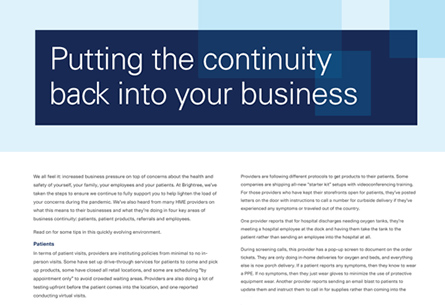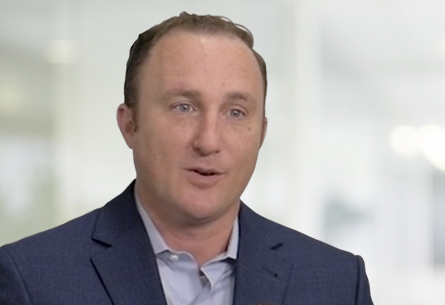When business is anything but usual
We all feel it: increased business pressure on top of concerns about the health and safety of yourself, your family, your employees and your patients. At Brightree, we’ve taken the steps to ensure we continue to fully support you to help lighten the load of your concerns during the pandemic. We’ve also heard from many HME providers on what this means to their businesses and what they’re doing in four key areas of business continuity: patients, patient products, referrals and employees.
Read on for some tips in this quickly evolving environment.
Patients
In terms of patient visits, providers are instituting policies from minimal to no in-person visits. Some have set up drive-through services for patients to come and pick up products, some have closed all retail locations, and some are scheduling “by appointment only” to avoid crowded waiting areas. Providers are also doing a lot of testing upfront before the patient comes into the location, and one reported conducting virtual visits.
Pre-screening questions regarding COVID-19 are also being asked prior to a patient coming into the office. For example:
- “Have you or a person in your home tested positive to COVID-19?”
- “Do you have any symptoms for fever over 100, coughing, or shortness of breath?”
- “Have you been traveling out of the country?”
- “Do you have underlying health issues?”
The value of asking questions like these is not in deciding whether you’re going to care for the patients; but, instead, it’s to alert you to the precautionary measures you need to take when supplying for that patient. For instance, if you need to be prepared with PPE. If, however, a patient is requiring a CPAP setup but is reporting any of those symptoms, then providers report pushing out the visit for 14 days versus risking the interaction.
Patient products
Providers are following different protocols to get products to their patients. Some companies are shipping all-new “starter kit” setups with videoconferencing training. For those providers who have kept their storefronts open for patients, they’ve posted letters on the door with instructions to call a number for curbside delivery if they’ve experienced any symptoms or traveled out of the country.
One provider reports that for hospital discharges needing oxygen tanks, they’re meeting a hospital employee at the dock and having them take the tank to the patient rather than sending an employee into the hospital at all.
During screening calls, this provider has a pop-up screen to document on the order tickets. They are only doing in-home deliveries for oxygen and beds, and everything else is now porch delivery. If a patient reports any symptoms, then they know to wear a PPE. If no symptoms, then they just wear gloves to minimize the use of protective equipment wear.
Another provider reports sending an email blast to patients to update them and instruct them to call in for supplies rather than coming into the office.
Referral
There are also referral challenges that need to be considered in your overall business continuity plan. When sleep labs are closed, or appointments are canceled, or there are no shows, there’s a strain on new setups. Or, if a facility is closed, how do providers handle deliveries and get signatures on documents? Some providers report using interoperability tools like GoScripts to keep their resupply programs moving uninterrupted.
Another provider reports reaching out to referrals to strengthen the partnership and alert them that they have ventilator inventory or other specialized equipment on hand for them if they need it.
Employees
From an employee standpoint, providers are reporting anywhere from 25 to 75 percent of their employees working from home – including therapists who are doing videoconferencing for face-to-face setups. This includes putting several protocols in place to ensure laptops, desktops, VPNs and cybersecurity were all available for remote employees, and discussions are ongoing on how to keep employees connected with one another and with patients.
There are, of course, employees who can’t work from home – delivery drivers, technicians, etc. – who must go through aggressive self-screening programs before entering buildings.
One provider reports following a hospital incident command structure where everyone is trained on a specific role such as communications, operations, education planning, logistics for tracking equipment like ventilators, and resources for determining how many skilled people you need and in what division. The incident command is fluid and can be modified to fit your needs. For instance, in the current climate, there is a role for an infection preventionist who is in charge of employee safety and education.
From patients and patient products to referrals and employees, HME providers are sharing their practices to help navigate the new normal. Look for more updates from Brightree.
What’s working for you? Visit Brightree Community to share your business continuity best practices with other providers.


